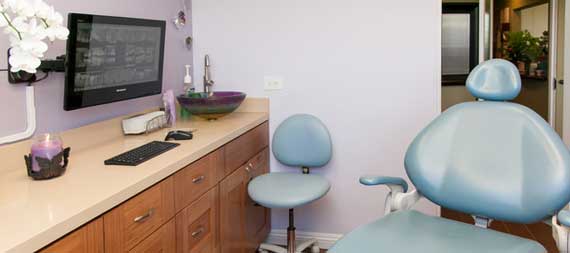
Tooth bonding is a procedure that involves the application of a tooth-colored material along with adhesives and a high-intensity curing light to harden the material. Bonding is a cosmetic method used by dentists to improve the appearance of a patient's chipped or discolored tooth. It is also used to fill in spaced teeth, and make teeth appear longer and more symmetrical. Bonding is often used as an alternative to the application of amalgam fillings, or to protect a section of the tooth's root from receding gums.
What to Expect
Patients considering getting a bonding procedure will be happy to know that it takes little or no preparation, and often doesn't require anesthesia unless the bonding will be used to fill a tooth cavity. In addition, Dr. Gerayli will try to match the shade of the composite resin to the natural teeth as closely as possible.
Direct Composite Bonding and Adhesive Bonding
Direct composite bonding is the dental process tooth-colored composites (natural-looking materials) are used to repair holes from tooth decay, repair tooth splits or tooth chips, close spaces teeth and build up jagged, fractured or worn down edges of the teeth within a cosmetic dentistry office. Composite materials may also be directly bonded and sculpted to teeth's surfaces which are the most well-known for minimally invasive smile makeovers.
Adhesive Bonding
In contrast to the process of direct composite bonding is adhesive bonding which involves attaching a restoration to the tooth. This method is commonly used for bridges and inlays/onlays, porcelain veneers, and aesthetic crowns. After Dr. Gerayli has selected a color that matches the shade of your teeth, she will use a gentle phosphoric acid solution to etch (roughen) the surface of the tooth to prime it for the bonding agent. Next, a liquid bonding agent is applied after the roughening agent is removed. The tooth-colored pliable resin is applied to the tooth, then shaped and smoothed until it reaches the desired shape. The material is then hardened with an ultraviolet ray, and the prior step is done again until the direct composite veneer or filing is shaped to the Dr. Gerayli's satisfaction. Your dentist will then buff the finished product to match its luster with the rest of the tooth's surface.
Pros of Dental Bonding
Dental bonding is one of the least expensive and most common procedures performed in cosmetic dentistry. Dental bonding generally be done in a brief, single office visit unless multiple teeth are involved. Another plus of bonding it requires little to no removal of tooth enamel compared to veneers and crowns. Dental bonding overall doesn't require anesthesia.
Cons of Dental Bonding
Dental bonding materials aren't as strong as natural teeth. It's important that patients keep in mind that crunching on ice, chewing on pens, and biting on fingernails can actually chip the material. Another downside to bonding is it only lasts a few years before it needs to be repaired and is not as durable as crowns, veneers, or fillings or other restorative procedures.
Bonding materials aren't resistant to stains as much as crowns. We at Victory Cosmetic Dentistryvrecognize that there are several limitations associated with the application of bonding materials and may opt to only use these materials to perform minor superficial changes, temporary correction of superficial flaws, and correcting teeth (e.g. front teeth) that exert a very low bite pressure. Dr. Gerayli will give you more details of whether the bonding procedure is the right fit for you and/ or make other recommendations related to your dental restoration.
Teeth Bonding Cost
The cost of teeth bonding varies on the dentist performing the procedure, number of teeth that need cosmetic repair, specific dental conditions, and additional procedure performed in conjunction with this procedure.
Composite dental bonding is the ideal choice if patients need to fix much larger cosmetics problems such as:
- Rotated or slightly overlapped teeth.
- Darkly yellowed or stained from avid coffee drinking, smoking or age.
- Discolored or grayed teeth caused by taking medications like tetracycline.
Caring for Bonded Teeth
Patients should keep in mind that maintaining good oral hygiene extends to any dental work done in their mouths in conjunction with their natural teeth. Brush and floss your teeth at least twice daily to prevent the buildup of plaque and other debris from your dental work. Go to routine checkups recommended by Dr. Gerayli to ensure that your teeth stay healthy. Since the bonding material can chip, refrain from eating hard candy, food, ice or gnawing on pens or your nails. Sometimes a bonded tooth will loosen which needs to be addressed by Dr. Gerayli as soon as possible.
Teeth Bonding Consultation
Get a consultation with Dr. Gerayli to determine what dental problems can be resolved with bonding. Since no two patients' oral issues are exactly the same, Dr. Gerayli will thoroughly examine your teeth to personalize your care, which may involve the taking of x-rays and a teeth and gum evaluation. During your consultation, Dr. Gerayli will discuss how bonding can repair the structure and appearance of gaps, "short teeth," cracked or chipped teeth, decayed teeth, tooth discoloration, to name a few. If you have teeth that are very bad shape Dr. Gerayli may recommend alternative restorative or cosmetic procedures to aid you with your long-term smile.





